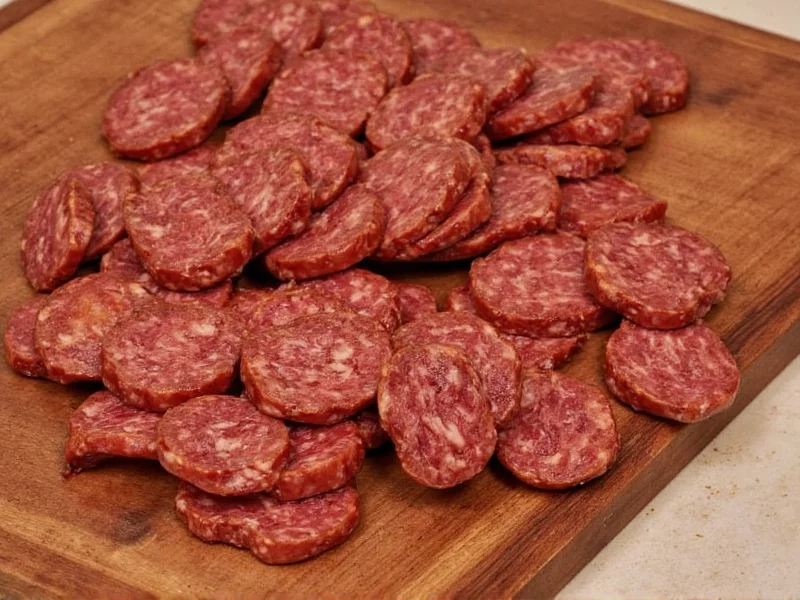Creating delicious venison sausage transforms lean game meat into flavorful, juicy links that preserve your harvest. Unlike traditional pork sausage, venison requires careful attention to fat content and temperature control to prevent dry, crumbly results. This comprehensive guide provides professional techniques honed through decades of wild game processing, ensuring your venison sausage turns out perfectly seasoned, properly textured, and safe to eat every time.
Why Venison Sausage Needs Special Handling
Venison's extremely lean composition (typically 2-5% fat compared to pork's 25-30%) creates unique challenges for sausage making. Without adequate fat, venison sausage becomes dry and lacks the emulsified texture that makes sausage enjoyable. The ideal venison sausage maintains a precise 70% lean meat to 30% fat ratio. Many home processors fail by using insufficient fat or improper chilling, resulting in poor binding and texture issues.
Professional sausage makers emphasize temperature control as critical - all components must remain below 40°F during preparation to prevent fat smearing, which destroys texture. Understanding these fundamentals separates successful venison sausage from disappointing attempts.
Essential Equipment Checklist
While basic sausage making requires minimal tools, investing in proper equipment significantly improves results, especially with lean venison. Here's what you'll need:
| Equipment | Why It Matters for Venison | Professional Tip |
|---|---|---|
| Commercial meat grinder | Prevents fat smearing with sharp blades and proper speed | Chill grinder parts in freezer 1 hour before use |
| Sausage stuffer (manual or electric) | Ensures consistent filling without air pockets | Use fibrous casings for larger diameter sausages |
| Natural hog or sheep casings | Provides traditional texture and appearance | Soak in warm water 30 minutes before use |
| Digital meat thermometer | Critical for food safety with game meat | Calibrate before each use for accuracy |
| Large stainless steel bowls | Maintains cold temperature during mixing | Place bowls in freezer between steps |
Perfect Venison Sausage Ratio and Ingredients
The foundation of exceptional venison sausage lies in precise ratios and quality ingredients. Unlike store-bought sausage recipes, venison requires specific adjustments to compensate for its leanness.
Meat and Fat Composition
For every 5 pounds of venison sausage:
- 3.5 pounds (70%) venison trimmings (chilled below 35°F)
- 1.5 pounds (30%) high-quality fat source
Recommended fat sources:
- Pork back fat (best option for traditional texture)
- Bacon (adds subtle smokiness)
- Beef kidney fat (traditional for some regional styles)
- Pre-chilled butter (for immediate cooking sausages only)
Basic Seasoning Blend (per 5 pounds)
- 3 tablespoons non-iodized salt (essential for protein extraction)
- 1.5 tablespoons freshly ground black pepper
- 2 teaspoons garlic powder
- 1 teaspoon onion powder
- 1 teaspoon dried thyme
- 0.5 teaspoon red pepper flakes (optional)
- 0.25 cup ice-cold liquid (wine, broth, or water)
For breakfast-style venison sausage, replace black pepper with 1 tablespoon rubbed sage, 1 teaspoon marjoram, and 0.5 teaspoon nutmeg.
Step-by-Step Venison Sausage Preparation
1. Prepare and Chill All Components
Cut venison and fat into 1-inch cubes. Place in separate containers and chill in refrigerator for 12 hours, or freeze for 1-2 hours until meat is firm but not frozen solid (ideal temperature: 28-32°F). Chill all equipment in freezer.
2. First Grind
Using coarse grinding plate (8-10mm), grind chilled meat and fat together. Work quickly to maintain cold temperature. Spread ground meat in shallow pan and return to refrigerator for 30 minutes.
3. Mix Seasonings
Combine all seasonings with ice-cold liquid. Pour over chilled ground meat. Mix thoroughly using clean hands or gloved hands for 3-5 minutes until mixture becomes sticky and emulsified. This protein extraction is critical for proper binding.
4. Test Cook
Form small patty and cook to 160°F. Taste and adjust seasonings as needed. This step prevents disappointing results after stuffing.
5. Second Grind (Optional)
For finer texture, pass mixture through medium grinding plate (4.5mm). Skip this step for country-style sausage.
6. Stuff Casings
Thread casing onto stuffer tube, leaving 4-6 inch tail. Fill casing firmly but not tightly, maintaining consistent pressure. Twist into 6-inch links, leaving 1 inch between twists.
7. Rest and Set
Refrigerate sausages uncovered for 12-24 hours before cooking. This allows flavors to meld and casing to adhere properly.
Troubleshooting Common Venison Sausage Problems
Dry or Crumbly Texture
Cause: Insufficient fat content or improper chilling during processing
Solution: Maintain strict 70/30 ratio and ensure all components stay below 40°F. Add 1-2 tablespoons additional fat per pound if needed.
Sausage Falls Apart When Cooking
Cause: Inadequate protein extraction during mixing
Solution: Mix longer (5-7 minutes) until mixture becomes noticeably sticky. Ensure proper salt content for protein binding.
Grainy Texture
Cause: Fat smearing from warm equipment or over-processing
Solution: Chill all equipment thoroughly. Avoid multiple grinds unless necessary. Work quickly during warm weather.
Storage and Cooking Guidelines
Properly made venison sausage can be stored using these methods:
- Refrigeration: 3-4 days in coldest part of refrigerator
- Vacuum sealing: 6-8 months in freezer
- Traditional freezing: Wrap tightly in freezer paper, 2-3 months
When cooking venison sausage:
- Always cook to minimum internal temperature of 160°F
- For fresh sausages, poach in 160-170°F liquid for 10-15 minutes before finishing on grill
- Never pierce sausages while cooking to prevent juice loss
- Allow 5 minutes resting time after cooking for optimal juiciness
Flavor Variations for Venison Sausage
Italian Venison Sausage
Replace basic seasoning with: 2 tablespoons fennel seed (lightly toasted and crushed), 1 tablespoon dried oregano, 1 teaspoon crushed red pepper, 3 cloves minced garlic. Add 0.25 cup dry red wine to liquid component.
Smoked Venison Breakfast Sausage
Use 1 tablespoon rubbed sage, 2 teaspoons maple sugar, 1 teaspoon smoked paprika, and 0.5 teaspoon nutmeg. Add cure (1 teaspoon Prague powder #1 per 5 pounds) if planning to smoke.
Southwestern Venison Chorizo
Include 2 tablespoons smoked paprika, 1 tablespoon cumin, 2 teaspoons chipotle powder, 0.5 cup fresh orange juice, and 1/4 cup cider vinegar. Use pork fat for traditional texture.











 浙公网安备
33010002000092号
浙公网安备
33010002000092号 浙B2-20120091-4
浙B2-20120091-4